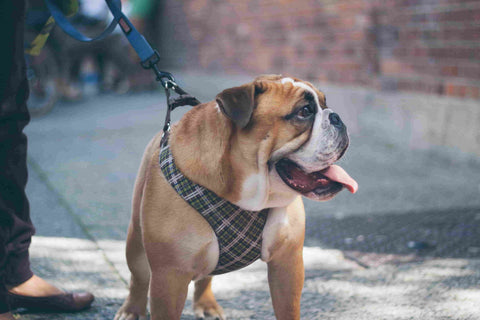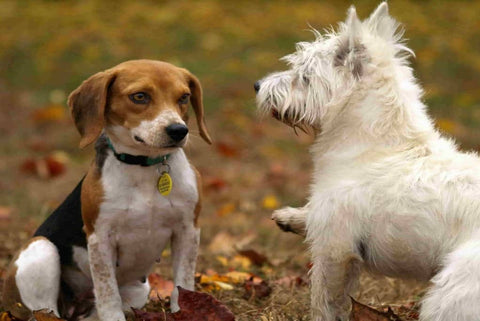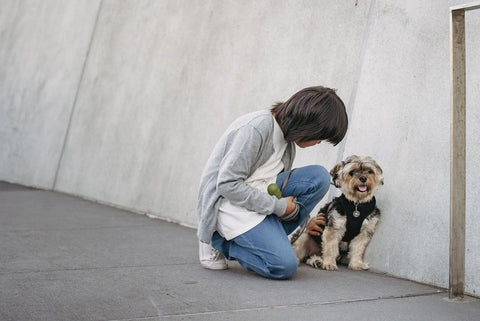How to Fit a Dog Harness Properly & Safely
A dog harness is an essential gear for your pup. It keeps them safe when you’re out and about, and it can also help with training. But, if it’s not fitted correctly, a harness can do more harm than good.
In this dog harness fitting guide, we will uncover the major aspects that will help you achieve the best dog harness fit for your furry friend. So, whether you’re just starting or using a harness for a while now, make sure to read on!
Get the Proper Dog Harness
One crucial thing to do right when you get a dog is to make sure you have the proper equipment, like a good dog harness. A harness will help keep your furry friend safe on walks, and it's much more comfortable for them than a traditional collar. Here are some factors to consider on how should a dog harness fit.
Proper Size
The last thing you want is for your dog to be uncomfortable or for the harness to be too loose and not provide the support your dog needs. Here are a few tips on how to make sure you get the right fit for your dog:
- Measure your dog around the chest, just behind the front legs. This will give you an idea of what size harness you need.
- Try the harness on your dog before making any adjustments. You want to ensure that the straps are not too tight or loose.
- If the harness has adjustable straps, loosen them up before putting the harness on your dog. Then, you can tighten them as needed to get a snug fit.
- Ensure the harness is not too tight by putting two fingers between the straps and your dog's body. There should be some room, but the harness should not be so loose that it slides around.
- Check the D-ring (the ring where you attach the leash) is in the middle of your dog's back. This will help balance and prevent your dog from pulling too much to one side.
Adjustment Straps
A dog harness should be tight enough that it can't slip off but loose enough that your dog is comfortable. The strap should sit high on your dog's chest, just behind the front legs. You should be able to fit two fingers under the straps at the broadest part of your dog's chest.
The belly strap should sit low on your dog's belly, in line with their back legs. It shouldn't be so tight that it causes discomfort, but it shouldn't be so loose that it could slip off.
If you're unsure how to adjust the dog harness, or you're having trouble fitting the harness properly, please don't hesitate to ask a member of our team for help.
Other Great Features of a First-Class Dog Harness
- Double Clip Design: The Double Clip Design is an excellent feature of this harness because it allows you to put the harness on your dog quickly and easily. It attaches to the front and back of the harness, so you can get a good fit without having to adjust the straps. This is especially helpful if you have a wriggly dog who doesn't like to stand still for long!
- Easy to Put On & Off: You shouldn't have to wrestle with your dog or force them into it. The best harnesses will have a simple design that you can slip on and clip closed in just a few seconds. And when it's time to take it off, they'll unclip just as easily.
- Soft Padding: Soft padding provides comfort for your dog and prevents chafing. The padding should be breathable, so your dog doesn't get too hot while wearing it.
- Breathable Material - A dog harness should be made of breathable material that prevents your dog's sweating, skin irritations, hair matting, and tangling.
- Reflective Strips - Reflective strips are a great safety feature, especially if you walk your dog at night. The reflective strips will make your dog visible to cars and other people, which can help prevent accidents.
Adjust the Harness to Your Dog’s Body
Even if you have the correct size harness for your dog, you must double-check by properly fitting a dog harness. Depending on a dog's age, breed, and body structure, a harness can fit differently. This is why it's important to adjust each harness to your dog's body individually. Doing this can ensure your dog is comfortable and safe while wearing its harness.
There are several methods to ensure the harness fits properly to your dog:
- Two-finger rule: The Two-finger rule is a method to fit your two fingers underneath the harness straps at any point. If you can't, it's too tight and needs to be loosened.
- Try to pull the harness over your dog’s head: The best way to check if the harness fits properly is to try to pull the harness over your dog’s head. If the harness is too loose, your dog may be able to wiggle out of it and escape. If it’s too tight, it will be uncomfortable for your dog to wear and can restrict their movement.
- Adjust the harness to what works best for both of you: You also want to make sure that the harness is comfortable for your dog to wear. If it’s not adjusted correctly, it could rub their skin raw, cause sores, and restrict their breathing or movement.
Signs That Your Dog Harness Isn’t Fitting Right
If you're a dog owner, keep your pup safe while on walks using a dog harness. Your responsibility is to know how a harness should fit on a dog because they could develop breathing problems or even choke if it's too tight.
On the other hand, if it's too loose, they might be able to wiggle out of it easily, putting them in danger of getting run over by a car. So how can you tell if your dog's harness isn't fitting right? Check out these signs!
- Your dog easily escapes/wiggles out of it: A well-fitting harness should be snug but not too tight and stay in place even when it is wiggling around. If your dog's harness is constantly slipping off or coming undone, it's time to find a new one.
- Your dog’s losing hair around the harness area and the hair under a harness is matting and tangling: If you notice your dog is losing hair around the harness area, it's a sign that the harness isn't fitting right. The hair under a harness can also matt and tangle, which can be uncomfortable for your dog.
- Your dog’s chafing under the armpits or around the harness: The harness isn't fitting right when there is a sign of chafing under the armpits or around the harness. You'll want to make sure you adjust the straps accordingly. You may also want to consult a professional to ensure you're doing everything correctly.
- The back piece rotates to the side: If you notice that the back part of the harness is rotating to the side, it is not fitting correctly. This can be dangerous, as it can cause your dog to slip out of the harness and run off.
- The chest section of a harness loosens on your walk: Always ensure the chest section of the harness is snug and secure before heading out for a walk. This can be dangerous, as it could cause your dog to slip out of the harness and run away.
Why Does A Proper Dog Harness Fit Matter?
Knowing how to fit a dog harness is essential for several reasons.
First, it ensures your dog is comfortable while wearing the harness. Second, it helps to distribute the weight of the harness evenly so that your dog isn't carrying too much weight on one side. Third, it helps prevent the harness from slipping off or becoming loose while your dog is wearing it. Finally, a properly fitting harness can help avoid injuries while your dog is wearing it.
Get the Best Harness for Your Dog From Pet & Cuddle!
To make walks with your dog more enjoyable, Pet & Cuddle is here to help you! Our harnesses are made from high-quality materials designed to provide maximum comfort for your dog. They are also adjustable so that you can find the perfect fit for your furry friend.
What's more, our harnesses come in various colors and styles, so you can find the perfect one to match your dog's personality. And because we know that safety is important to you, our harnesses are also equipped with reflective strips so that you can keep an eye on your dog at night.
Get the best harness for your dog from Pet & Cuddle today!
Common Questions About Dog Harnesses
Are you a dog owner thinking about using a harness for your pet, but you're not sure which one to choose? You're not alone! Below we'll answer some of the most common questions people have to know about choosing the perfect dog harness!
How tight is a harness supposed to be on a dog?
When you get your dog a new harness, you should ensure that it fits correctly. To do this, ensure you can slip two fingers underneath any strap on the harness. If it's too difficult, the harness is likely too tight. Try to pull it over your dog's head to make sure it's not too loose. If it slips off, it's too loose.
How loose should a dog harness be around the neck?
A dog harness should be snug enough to fit no more than two fingers between the harness and your dog's body. This makes it tight enough that your dog can't back out of it and loose enough that it won't chafe your dog's skin. If you’re using a no-pull harness, the leash ring should sit high on the chest.
Can my dog's harness hurt him?
The main thing to remember is that the harness needs to fit well. Otherwise, it could cause your dog some discomfort. Make sure to take accurate measurements of your dog's chest and neck before purchasing a harness, and always err on the side of caution by buying a size up if you're unsure. With the right fit, your dog can enjoy all the benefits of wearing a harness without any negative side effects.
What type of harness is best for a dog?
No matter what type of harness you choose, you should ensure that it properly fits your dog. The last thing you want is for your dog to be uneasy and escape from its harness.
Aside from that, think about the training or activities you’ll be doing with your dog. In most cases, you can’t go wrong with a versatile dual-clip dog harness. With this type of harness, you’ll be able to attach a leash to either the front or back clip. This is ideal for giving your dog more freedom while remaining under your control.




